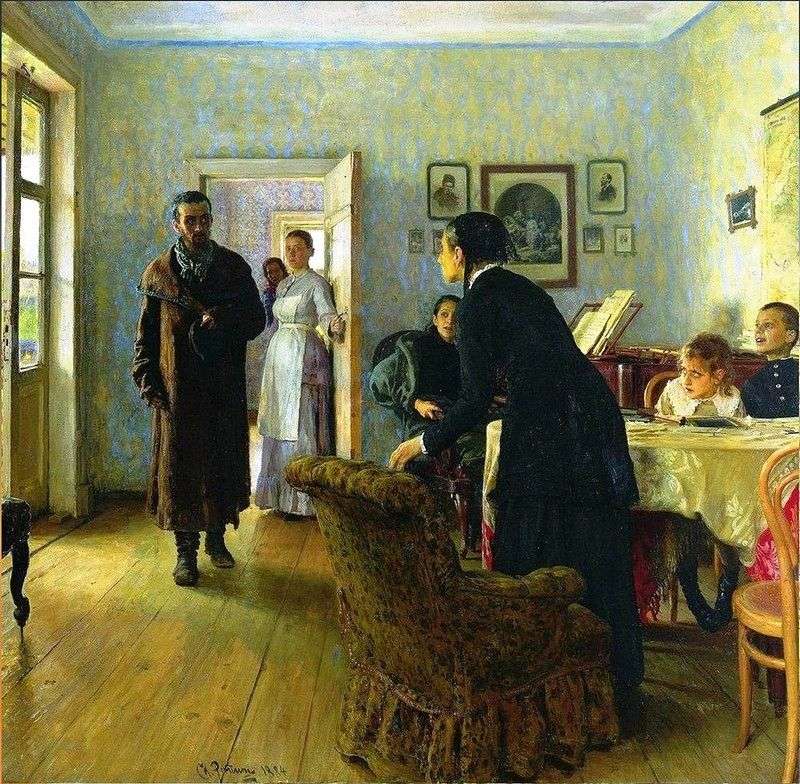
Repin’s painting “Did not wait” has two options. In the first variant, a girl returned to the family, and she was met by two sisters. The picture was small. Following it in 1884, Repin begins another option, which becomes the main one.
The picture was painted quickly and in 1884 was exhibited at a traveling exhibition. But then Repin worked on it, changing mainly the facial expression of the incoming and partly facial expressions of his mother and wife. The second option was the most significant and monumental of Repin’s canvases on revolutionary themes.
In the painting “We did not wait” Repin found such a plot, which allowed him to create a canvas of great ideological content, revealing his talent of a genre painter, his mastery of psychological characteristics. Before us is an image of a typical intelligent family in its usual setting. The heroic revolutionary themes in the film “Did not wait” appear in the primary form of the genre picture of modern life. Due to this, genre painting itself and modern life were elevated to the rank of a historical picture.
The internal theme of the picture was the problem of public and personal relations. The main task of the picture was to convincingly show precisely the unexpectedness of the revolutionary’s return, the diversity of the experiences of himself and his family. In the picture with full force turned repinsky talent of expressive characteristics. Each of the characters is outlined and served with exceptional strength and bulge, up to such minor characters as a servant in the doorway or a little girl at the table.
Not only facial expressions are remarkable, but also the very poses of the actors, the plasticity of their bodies. Particularly revealing in this respect is the figure of a mother who has risen to meet the incoming old woman. The dark figure of the boots who returned in brown armored clothes and large boots trampled in the open spaces brings into the family interior something from Siberia and hard labor, and with it, pushing the walls of the house, here, in the family, where they play the piano and the kids prepare lessons, as if in the bulk of history, the harsh cruelty of life and trials of a revolutionary. Repin builds a composition as a scene caught on the fly.
The actions of all the characters are depicted at the very beginning: the revolutionary is taking the first steps, the old woman just got up and wants to move towards him, the wife just turned around, the boy raised his head. All are caught unexpectedly, their experiences are still vague and uncertain. This is the first step of the meeting, recognition, when you still do not believe your eyes, you are not fully aware of what you see. Another moment – and the meeting will happen, people will rush into each other’s arms, crying and laughter, kisses and exclamations will be heard. Repin keeps viewers in constant suspense. Due to this, the decision is not given immediately ready, but is thought by the viewer himself.
Repin has succeeded remarkably in combining the important with the minor, significant with the little things that tell the scene of vitality, and bring lyrical warmth. Such, for example, is the image of a girl sitting at the table with curved legs dangling above the floor, the whole interior painted with love, such is the soft tender light of a summer day pouring through a half-dissolved balcony door, on the glass of which drops of recent rain are still visible.
The details of the setting have plot meaning. So, it is not for nothing that portraits of Shevchenko and Nekrasov, so common in this setting, are depicted over the piano, and between them there is an engraving from Steiben’s then popular Golgotha. The analogy with the gospel legend of suffering and sacrifice was very common among the revolutionary intelligentsia. The painting “We did not expect” is an outstanding canvas of Repin in the beauty and skill of her painterly decision. It is written in the open air, full of light and air, its bright color tells it to soften the drama soft and bright lyricism.
